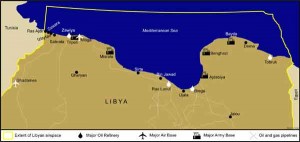Since the exit of President Mubarak in Egypt, the geopolitical contours of the Arab world has been changing rapidly. What was touted as a revolution for democracy has now degenerated into pure international power politics. The so-called ‘Jasmine Revolution’ has hit road blocks in Yemen, Bahrain and more importantly Saudi Arabia. The revolution for democracy theory has been torpedoed. Libya with its vast oil resources was too important for Europe, to allow it to lapse into uncertainty.
The Fault Lines
The 6.4 million Libyan people continue to be divided over regional and ethnic lines in the ongoing ‘Civil War’ since February 2011. Even geography conspires to accentuate this division. 90 percent of Libyans inhabit only 10 percent of the area, primarily along the coast.
Tripolitania in the west and Cyrenaica in the northeast are the two major population centers with a population density of 50 persons per square kilometer, but in the remaining areas it is less than one person per square kilometer. These two population centers are separated by one of the most formidable desert in the world, wherein in certain areas it rains once or twice in a decade.
 The other region is Fezzan in Southwestern Libya, which constitutes 30 percent of the country’s landmass. The people inhabiting this area are basically pastoralists, who cross borders of Algeria, Chad and Niger. The population in Fezzan is estimated to be 0.45 million i.e. nearly eight percent of the total population.
The other region is Fezzan in Southwestern Libya, which constitutes 30 percent of the country’s landmass. The people inhabiting this area are basically pastoralists, who cross borders of Algeria, Chad and Niger. The population in Fezzan is estimated to be 0.45 million i.e. nearly eight percent of the total population.
Tripolitania and Cyrenaica sided with Axis and Allied powers respectively during World War II. Subsequently, when Libya was granted independence in 1951 and King Emir Sayid Idris al-Sanusi, a Cyrenaican was installed as the head of the state with the support of Western powers. The people in Tripolitania resented while the people of Cyrenaica celebrated. In 1969, when a 27 year old Gaddafi along with 70 young army officers, overthrew King Idris in a bloodless coup, the reaction was in the opposite order.
The regional and tribal fault lines, in this fourth largest country in Africa, have therefore hardly been bridged over the years. Therefore, what is happening in Libya is far from an “˜Arab Revolution.
Under Idris, Cyrenaica benefited politically and economically. Idris in fact could not break the shackles of his Cyrenacian identity primarily because that was where he derived his power from.
Gaddafi on the other hand, tried to promote nationalism by repudiating the tribal system and by creating an Arab nationalist regime. It may be mentioned that Libya has 140 tribes and clans. Gaddafi’s search for a new national identity for Libya floundered due to the exigencies of political power. His power base essentially lay in the west to the central part of Libya. Euphemistically speaking, the Cyrenacian tribes were punished by Gaddafi all through his rule. It is these tribes which now sensed an opportunity and decided to strike back.
Gaddafi meanwhile is being stoutly supported by his own tribe Gaddadfa as well as Al-Magarha tribe.
The regional and tribal fault lines, in this fourth largest country in Africa, have therefore hardly been bridged over the years. Therefore, what is happening in Libya is far from an ‘Arab Revolution’. It is the events in Tunisia and Egypt have provided the opportunity and impetus. This is despite a sound economy. Libya has a very generous social security programme especially in the fields of housing and education.
External Dimension and Linkages
The external dimension and linkages to this so-called revolution in the case of Libya cannot be ignored.
If the Cold War was the impetus for the coup by Gaddafi, this time, Libya is engulfed by a different kind of revolutionary wave, which many consider as being inspired and abetted by the West.
The Arab Revolution in Egypt led by Nasser had significant impact on Libya. This revolution was at the height of Cold War and as an outcome there was request of British and American bases to be evacuated from Libya. It may be recalled that Britain and Libya had signed a 20 year friendship treaty and in 1954 US had setup the Wheelus Air base near Tripoli. By 1970, the British forces and American bases were withdrawn, and consequently, cooperation including in the field of defence between USSR and Libya intensified.
The coup by Gaddafi in 1969 should be seen as an adjunct of the Cold War. The discovery of oil in 1959 had raised the geopolitical stakes of the Soviet Union, US and Europe in the country. At the time of independence, Libya was one of the poorest countries in the world. Its most significant exports were metal scraps of World War II.




